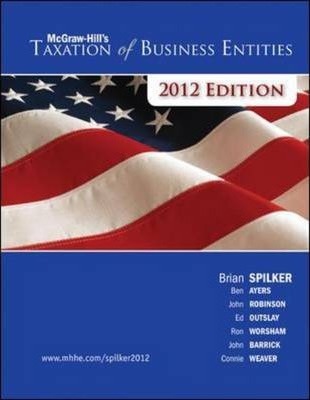
McGraw-Hill's Taxation of Business Entities 3rd Edition by Connie Weaver, Brian Spilker, Edmund Outslay, John Robinson, Ronald Worsham, Benjamin Ayers, John Barrick
Edition 3ISBN: 9780077924522
McGraw-Hill's Taxation of Business Entities 3rd Edition by Connie Weaver, Brian Spilker, Edmund Outslay, John Robinson, Ronald Worsham, Benjamin Ayers, John Barrick
Edition 3ISBN: 9780077924522 Exercise 20
Casey gave $1 million of stock to both Stephanie and Linda in 2005, 2006, and 2007. Calculate the amount of gift tax due and the marginal gift tax rate on the next $1 of taxable transfers under the following conditions:
a. In 2005, the annual exclusion was $11,000. Casey was not married and has never made any other gifts.
b. In 2006, the annual exclusion was $12,000. Casey was not married and the 2005 gift was the only other gift he has made.
c. In 2007, the annual exclusion was $12,000. Casey was married prior to the date of the gift. He and his spouse, Helen, live in a common-law state and have elected to gift-split. Helen has never made a taxable gift, and Casey's only other taxable gifts were the gifts in 2005 and 2006.
a. In 2005, the annual exclusion was $11,000. Casey was not married and has never made any other gifts.
b. In 2006, the annual exclusion was $12,000. Casey was not married and the 2005 gift was the only other gift he has made.
c. In 2007, the annual exclusion was $12,000. Casey was married prior to the date of the gift. He and his spouse, Helen, live in a common-law state and have elected to gift-split. Helen has never made a taxable gift, and Casey's only other taxable gifts were the gifts in 2005 and 2006.
Explanation
Gift tax
Gift tax is levied on tax paye...
McGraw-Hill's Taxation of Business Entities 3rd Edition by Connie Weaver, Brian Spilker, Edmund Outslay, John Robinson, Ronald Worsham, Benjamin Ayers, John Barrick
Why don’t you like this exercise?
Other Minimum 8 character and maximum 255 character
Character 255


